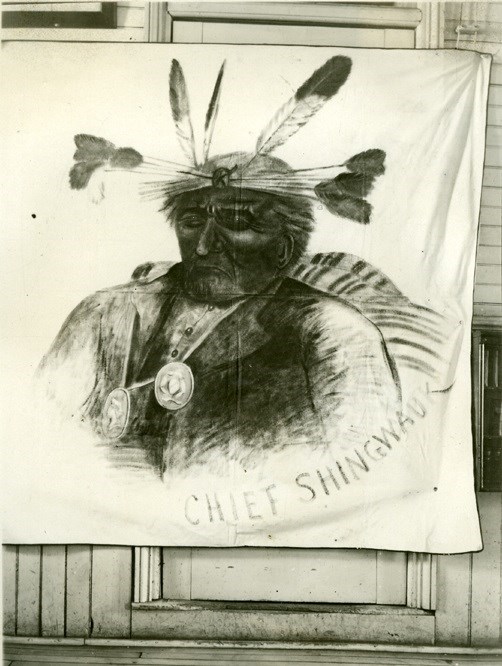From the archives of the Sault Ste. Marie Public Library:
Many Saultites are familiar with Shingwauk Residential School but how many know about the man it was named after? Chief Shingwauk (Shingwaukonse) or Little Pine was born in 1773 south of Lake Superior.
From a young age he showed himself to have many qualities befitting a chief, which were revealed by his conduct and skills in augury (an ability to interpret omens). It was said by the age of 14 or 15 he had fasted 10 times. He was well experienced in native picture writing and mnemonics (improving memory) which would prove to be invaluable in passing down history through an oral tradition.
He gained prominence during the War of 1812 when he fought alongside the British forces and fought with Techumseh and Isaac Brock. His son Buhgwujjenene recalled a story of how his father and his warriors killed sixty enemies while only losing twenty. He received a medal from King George III for his acts of bravery during the war.
He moved to Garden River, Ontario in 1836 where he met the historian Henry Schoolcraft and they became very good friends. Henry Schoolcraft is well-known for documenting the history of the Indigenous Peoples.
Chief Shingwauk had the authority to draw up land deeds and perform other legal documents. His name appears on a number of treaties such as the Treaty of St. Mary’s in 1820, which was arranged with Governor Cass of Michigan. Shingwauk also represented the Ojibways in the signing of the Robinson-Huron Treaty in 1850. One of the features of this treaty involved setting aside the Garden River Reserve for the Ojibways.
Shingwauk practiced the ceremonies of the Meda (a native spiritual practice) but stopped in 1830. In 1835, he and his sons Augustin and Buhgwujjenene converted to the Church of England. He wanted his people to learn how to read and write in English and wanted a school in order to educate them.
In 1832, he snowshoed to York (Toronto) to petition Lieutenant Governor John Colborne for a school. From 1827 to 1854 Shingwauk developed new native rights and self-determination strategy. This involved establishing “Teaching Wigwams” throughout Anishnabek lands which would supply a European style education while maintaining their indigenous culture. His sons Augustin and Buhgwujjenene were responsible for turning this dream into a reality. Unfortunately, the government’s policy was that of integration and assimilation and clashed with Shingwauk’s vision for educating his people.
Christianity became an important part of Chief Shingwauk’s life but his Ojibway beliefs continued to play a role in his life as well. Shingwauk had four wives and nine children, with his marriage to his last wife taking place in the Anglican Church.
Prior to his death in 1854 he was christened in the Anglican Church. Although the school that bore his name did not live up to his ideals, during his life he fought for what he believed was right for his people.
*************************
Each week, the Sault Ste. Marie Public Library and its Archives provides SooToday readers with a glimpse of the city’s past.
Find out more of what the Public Library has to offer at www.ssmpl.ca and look for more Remember This? columns here
